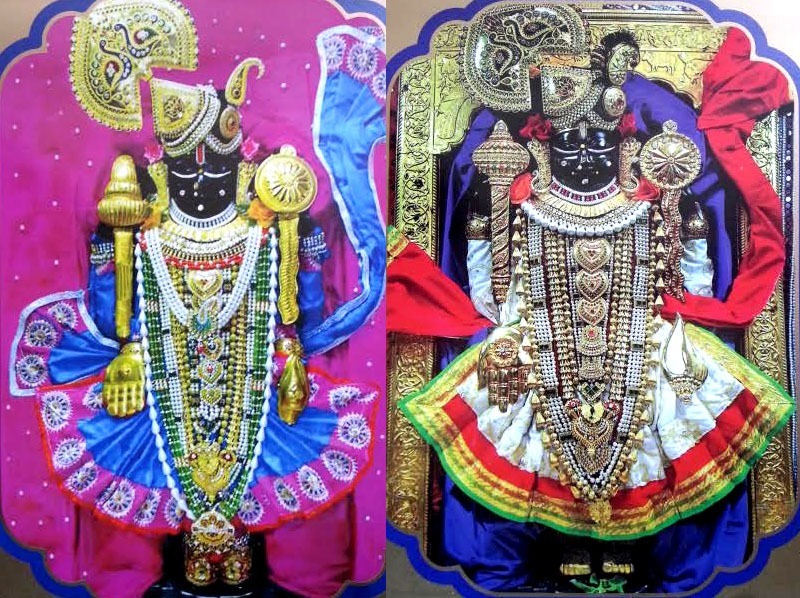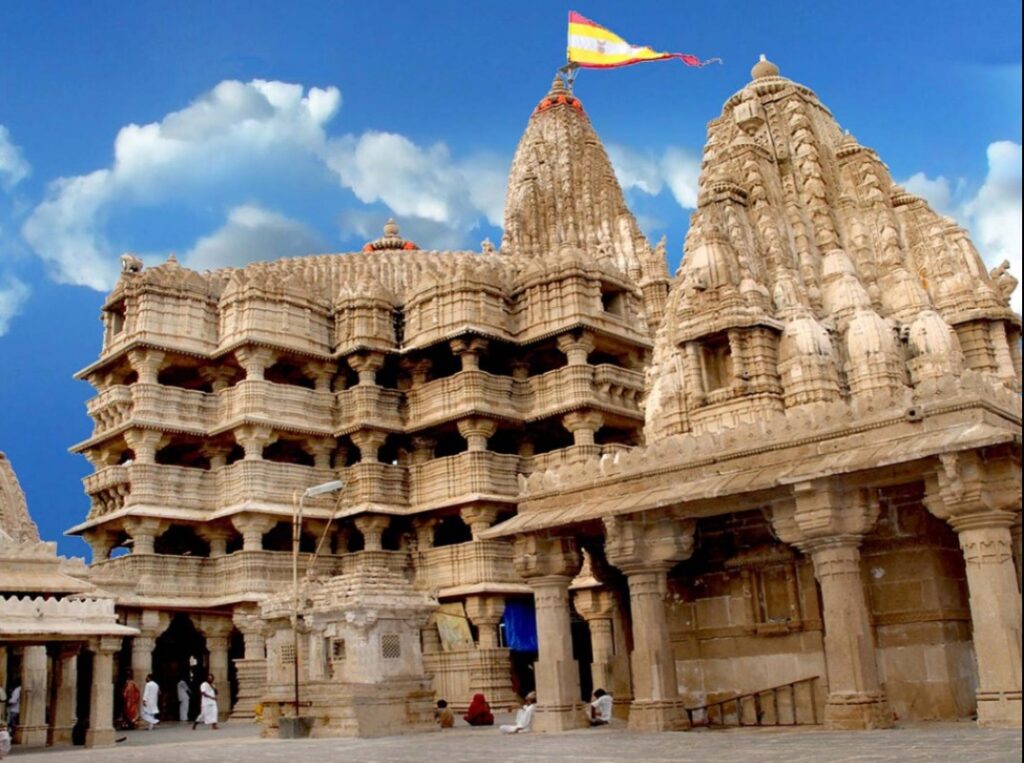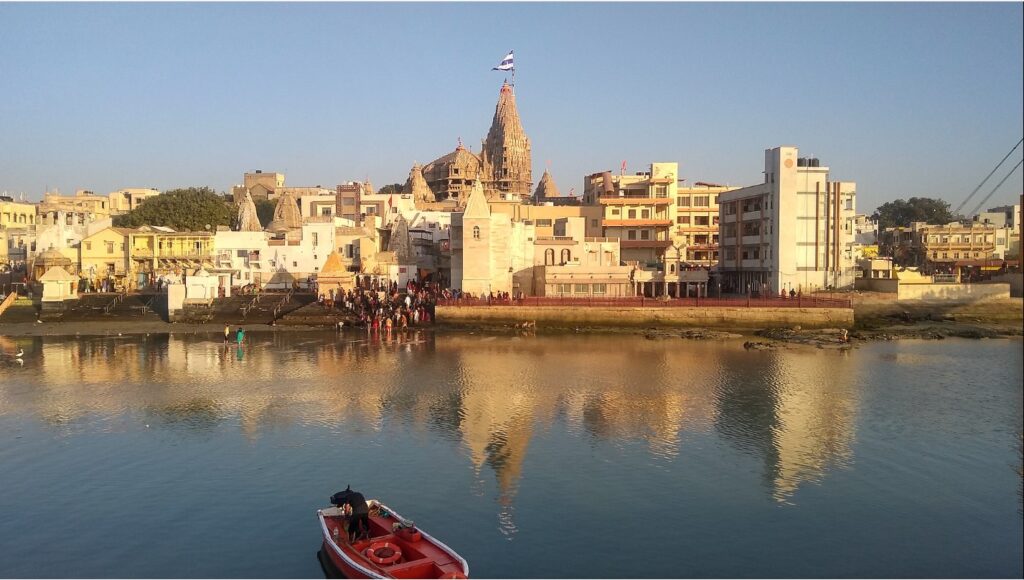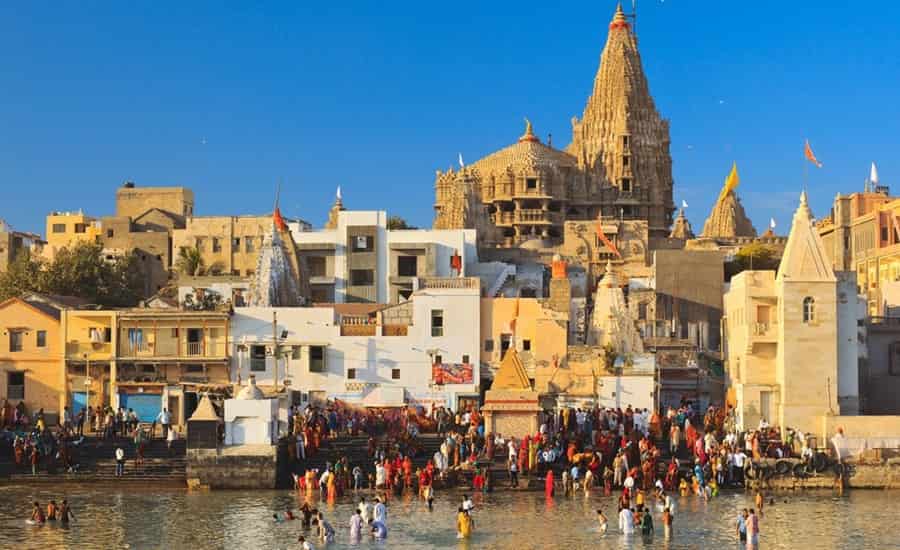
Dwarkadhish Temple, Dwarka, Gujarat
The Dwarkadhish Temple, also known as Jagat Mandir or Dwarakadheesh, stands as a revered Hindu shrine dedicated to Lord Krishna, honored here as Dwarkadhish, the ‘King of Dwarka.’ This temple is a pivotal destination in the Char Dham pilgrimage circuit, a sacred journey for Hindus. The main sanctuary, called Jagat Mandir or Nija Mandir, is a five-storied structure supported by 72 pillars, showcasing remarkable architectural grandeur.
Historical background and Architectural splendor
Dwarkadhish Mandir, situated in the town of Dwarka, Gujarat, has a storied history deeply embedded in Hindu mythology. Dating back to around 2500 BCE, it is believed to have been established by Vajranabha, the grandson of Lord Krishna, commemorating the divine presence in the legendary city of Dwaraka Kingdom. Over the centuries, the temple faced challenges, notably during the fifteenth century when Mahmud Begada plundered Dwarka, resulting in the destruction of the Dwarkadhish temple and its idol. However, the resilience of the devotees and the religious significance of Dwarkadhish Mandir endured, and in 1559, Adi Shankaracharya reinstalled the present idol, solidifying its status as a revered pilgrimage site.
The architectural splendor of Dwarkadhish Mandir is evident in its five-story structure adorned with intricate carvings, showcasing the enduring devotion to Lord Krishna. Today, the temple stands not just as a place of worship but also as a symbol of cultural heritage, attracting millions of pilgrims annually who seek the divine blessings of Lord Krishna during festivals like Janmashtami. Dwarkadhish Mandir remains a testament to the enduring spiritual legacy of Dwarka and its significance in the hearts of Hindus worldwide.

Religious Significance
The Dwarkadhish Temple is a very important place for Hindus. It's like the home of Dwarkadhish, who is another form of Lord Krishna known as the 'King of Dwarka.' People go there as part of a special trip called the Char Dham pilgrimage, which includes visiting four holy places. The temple is not just a building; it's like a living story from a very old time when Lord Krishna lived in the legendary city of Dwaraka Kingdom, as mentioned in the Mahabharata.
For the people who love and believe in Lord Krishna, this temple is extra special. It's not just about praying; it's about showing deep love and faith. The temple has special ceremonies and celebrations that tell the story of Lord Krishna. Even when the temple faced challenges and had to be fixed many times, it shows how strong people's belief is. The Dwarkadhish Temple is more than a building; it's a place where people feel close to God and find peace.


Festival and Celebrations
Here the festivals celebrated are Janmashtami, Sharad Purnima, Diwali, Holi, Annakut Utsav, Rath Yatra
Surroundings area & attractions
- Rukmini Devi Temple: Dedicated to Lord Krishna's consort Rukmini, it is a significant pilgrimage site near Dwarkadhish Temple.
- Gita Mandir: A temple adorned with Bhagavad Gita verses, providing a spiritual experience with intricate carvings.
- Nageshwar Jyotirlinga: One of the twelve sacred Jyotirlingas representing Lord Shiva, a short drive from Dwarka.
- Sudama Setu: Also known as Sudama Bridge, believed to be the path taken by Sudama, offering picturesque views.
FAQ
The exact date of construction of the Dwarkadhish Temple is unknown. However, it is believed that the original temple was built in the 2nd century BCE. The present temple was built in the 15th–16th century.
The Dwarkadhish Temple is one of the most important Hindu pilgrimage sites in India. It is believed that Lord Krishna himself resides in the temple. Millions of devotees visit the temple every year to offer prayers to Lord Krishna.
According to one theory, the lost city of Dwarka was built on reclaimed land roughly 3500 years ago and was drowned in water when sea levels rose.
The Dwarkadhish Temple is open from 6:30 AM to 12:30 PM and again from 2:30 PM to 9:30 PM.
Devotees are expected to dress modestly when visiting the Dwarkadhish Temple. Men are required to wear a dhoti or kurta-pajama, while women are required to wear a sari or salwar kameez.
There are a number of facilities available at the Dwarkadhish Temple, including cloakrooms, restrooms, and a food court. There are also a number of shops selling religious artifacts and souvenirs
The Dwarkadhish Temple is well-connected by road, rail, and air. The nearest airport is Dwarka Airport, which is located about 15 kilometers from the temple. The nearest railway station is Dwarka Railway Station, which is located about 2 kilometers from the temple.
There are a number of hotels and guesthouses located near the Dwarkadhish Temple. There are also a number of dharamshalas, which are budget-friendly accommodation options.
There are a number of other places to visit near the Dwarkadhish Temple, including the Gomti River, the Bet Dwarka Island, and the Nageshwar Temple.
The Dwarkadhish Temple is a major pilgrimage site and a number of festivals are celebrated here throughout the year. Some of the major festivals celebrated at the temple include Janmashtami, Holi, and Diwali.
Photography is not allowed inside the main sanctum of the Dwarkadhish Temple. However, you can take photos in the temple complex and surrounding areas.
Yes, there are special darshan arrangements available for devotees who want to avoid long queues. These include “Aarti Darshan” (participating in the aarti ritual) and “Seva Darshan” (performing puja rituals with the help of a priest).
The temple is open year-round, but the best time to visit depends on your preference. The weather is pleasant from October to March, making it ideal for sightseeing. However, the Janmashtami festival in August-September attracts massive crowds and offers a vibrant experience.
Devotees often bring offerings like flowers, fruits, sweets, and holy water (Ganga Jal) to the temple. You can also purchase puja items like coconuts, incense sticks, and puja thalis from shops near the temple.
The temple houses the “Flag of Lord Krishna,” believed to be the original flag used by Krishna during the Kurukshetra war.
The “Garud Dwar” (gateway) is a beautifully carved structure depicting Garuda, the vahana (vehicle) of Lord Vishnu.
The “Gomti Kund” within the temple complex is a sacred water tank believed to have originated from the River Gomti
.
Dwarka Beach, known for its serene and clean shores, is a popular spot for relaxation and recreation.
Rukmini Devi Temple, dedicated to Krishna’s wife Rukmini, is another prominent pilgrimage site.
Beyt Dwarka, an island accessible by ferry, is known for its serene atmosphere and the ancient temple dedicated to Krishna’s friend, Sudama.
Foreign tourists are welcome to visit the Dwarkadhish Temple. However, as with all visitors, they are expected to respect the temple’s traditions, dress code, and code of conduct. Photography inside the main sanctum is usually prohibited
Visitor information
Entry Fee: No fee
Timings :
- 7:00 AM - 12:30 PM
- 5:00 PM to 9:00 PM
Darshan Days- All days
Address:
Gomti Ghat 56,Sidi Swargdwar Dwarka, Gujarat 361335
Notable Events and Incidents
- 2018: The temple underwent a grand celebration on the occasion of Sharad Purnima, attracting devotees from various parts of the country.
- 2013: Dwarkadheesh Temple witnessed a major fire incident, causing damage to a portion of the temple complex.
Connectivity :
- By Road: Dwarka is well-connected by road with major cities in Gujarat. Regular bus services and private taxis are available for convenient travel.
- By Rail:Dwarka Railway Station is the nearest railhead. It is connected to major cities in Gujarat and other parts of India.
- By Air:The nearest airport is Jamnagar Airport, approximately 137 kilometers away. From the airport, visitors can hire taxis or use other modes of transportation to reach Dwarka.
- Local Transportation: Auto-rickshaws, cycle-rickshaws, and taxis are readily available for local transportation within Dwarka, making it easy for visitors to explore the town and reach the temple.
